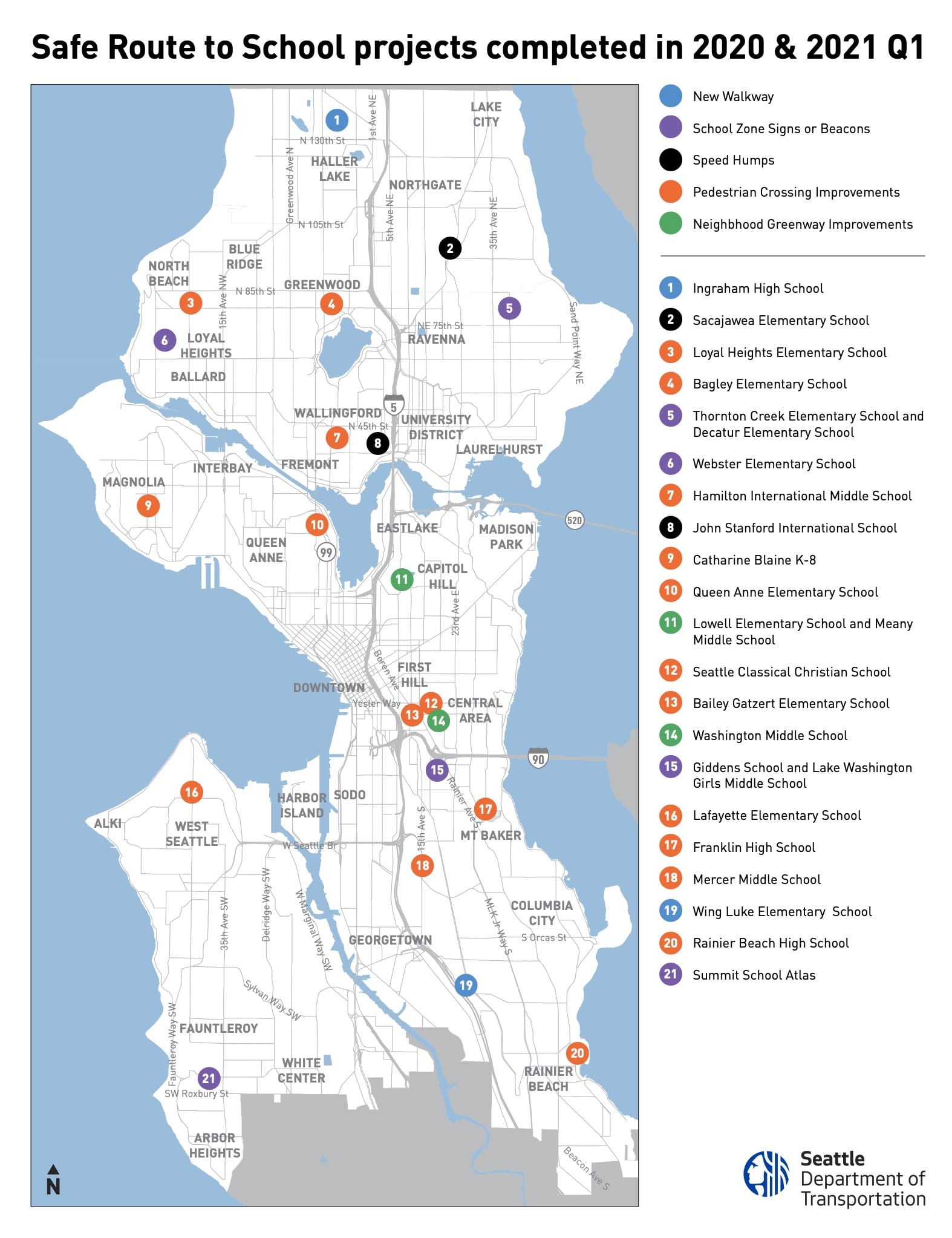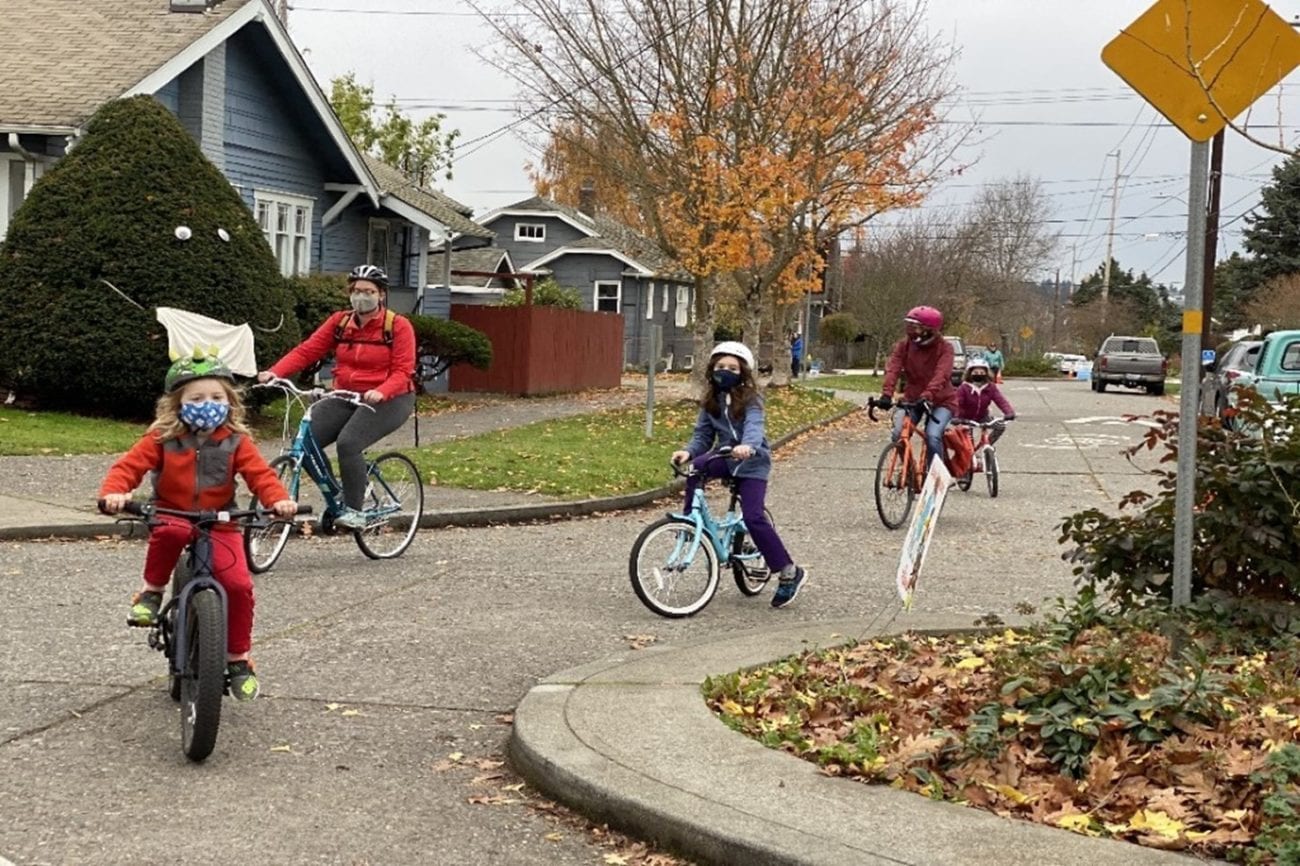 Students are headed back to their classrooms next week! Help keep our kids safe by driving the speed limit, obeying signs, and expecting more kids and families along our sidewalks and streets. Photo credit: Jeanne Clark
Students are headed back to their classrooms next week! Help keep our kids safe by driving the speed limit, obeying signs, and expecting more kids and families along our sidewalks and streets. Photo credit: Jeanne Clark Summary
- Students are headed back to their classrooms next week as Seattle Public Schools transition to in-person learning.
- Help keep our kids safe by driving the speed limit, obeying signs, and expecting more kids and families along our sidewalks and streets.
- Stay Healthy Streets and new “School Streets” in front of schools are open to people walking, rolling, and biking, and closed to pass through vehicles. If a street is closed to pass through vehicles in front of your school, please don’t drive on it.
- Since 2020, we’ve completed more than 20 Safe Route to School projects to increase safety for people walking, rolling, and biking near schools. These projects include new walkways, marked crosswalks, speed humps, school zone signs, and more!
- Schools, PTAs, and community groups can apply for a Safe Routes to School Mini Grant up to $1,000 to support and encourage kids to walk and bike to school.
Students are headed back to their classrooms next week! We’re working with schools to keep kids and families safe on their journey to and from school. Please do your part to keep our kids safe: drive the speed limit, obey signs, and expect more families and kids on our sidewalks & streets.
Seattle Public Schools transition to in-person learning for kindergarten through 5th graders on April 5th. Learn more about the district’s return to in-person learning plan on the Seattle Public Schools website.
Going back to the classroom is another huge transition for students, families, teachers, and school staff in our these highly unprecedented times. We’re working with Seattle Public Schools and private schools to help keep kids safe on their journey to and from school.

Hey kids & families, over the past year, many of you have explored your neighborhoods and found new walking, biking, and rolling routes. If you’re able, now’s the time to put your neighborhood navigation skills into action and walk, roll, bike, skip, or dance your way to school!
Seattle Public Schools shared that school bus service will be greatly reduced this spring. We know this affects families who typically rely on school bus service, especially those who live further away from their schools. If your family lives near your school, we encourage you to walk, bike, or roll to school. This will help reduce car congestion near schools.
Public transportation may also be an option for your family. High school and income-eligible middle school students at Seattle Public Schools can receive a free, unlimited 12-month ORCA card through our ORCA Opportunity Youth program.
Does your neighborhood have Stay Healthy Street? Find out on this map. Stay Healthy Streets are open to people walking, biking, and rolling and closed to pass through traffic. They might be your perfect route to walk, roll, or bike to school!
If you drive to school, please avoid driving on the Stay Healthy Streets when possible. If your school is directly on a Stay Healthy Street, we encourage people driving to park a block away from school to limit vehicles on the Stay Healthy Street.
We’re opening new “School Streets” which will be closed to most cars and open to families walking, biking, and rolling to school.
We’re supporting schools which have requested limitations to vehicles driving around school entrances. These new School Streets will be similar to Stay Healthy Streets and will provide more space for social distancing at school pick-up and drop-off.
These School Streets will be one or two blocks directly next to schools, and are clearly marked with “street closed” signs which means that they are closed to all pass-through traffic. So far SDOT is planning to open School Streets near Lowell, Emerson, Roxhill, and Olympic Hills Elementary Schools. SDOT will continue to support any additional schools who request a similar street closures.
For everyone’s safety, families dropping or picking up children should also avoid driving or parking on these streets. School buses and students mobility needs may still access the block. People driving who need to get to homes and businesses on a School Street are still able to drive on these streets. Drivers should use caution and yield to people on the street, but families enjoying the street should be mindful of drivers too.
Schools looking to improve their arrival and departure procedures are encouraged to look at our Arrival and Departure toolkit, developed for us by Feet First.
Twenty is Plenty. Drivers, play your part in making sure all our kids get to school safely: pay attention and take it slow in school zones all day long – not only at the typical start and end times we’re all used to.

Seattle Public Schools will be operating on new schedules with several new start and end times throughout the day, from 8 a.m. to 3:30 p.m., which means that children will be travelling to and from schools throughout the entire day and not just at the previous start and end times. All day long you should have your eye out for more kids walking along the street, on sidewalks, crosswalks, and riding in bike lanes.
20 MPH speed limits in School Zones will be in effect on school days and when children are present.
The flashing beacons (lights) on school zone signs will be activated during drop off and pick up times and enforcement will resume this month.
Seattle Police Department (SPD) will be turning back on school zone safety cameras around the city this month which will automatically send tickets to drivers photographed speeding. Lights on the signs will flash throughout the school day, warning drivers to slow down or get a ticket in the mail.
The speed limit in school zones and on all neighborhood roads (smaller roads that don’t have center lines painted) is 20 MPH. The speed limit on most major roads in Seattle is 25 MPH.
Slower speeds save lives. We know that when drivers slow down by just a few miles per hour, it has two main powerful effects. First, it makes crashes less likely to occur. And second, a person who is hit by a driver traveling a lower speeds is much more likely to survive the incident.

“I love our new crosswalk!” said Ada Meyer, a third-grader at Loyal Heights Elementary School. “The cars stop for us and let us safely cross the street. I can’t wait to get back to school next week.”
Through the Levy to Move Seattle, you are helping to make it safer and easier for students to walk, roll, and bike to school.

Safe Routes to School is a national movement to make it easier and safer for students to walk, roll, and bike to school. In 2020 and 2021 thus far, we completed more than 20 Safe Routes to School projects with your Levy to Move Seattle tax dollars. This includes installing a new Neighborhood Greenway, crossing improvements, speed humps, and more to slow people driving down and make people walking, rolling, and biking more comfortable and visible. (Read on to see some of the projects we completed over the last year!)
The Levy also funds Safe Route to School Mini Grants to encourage safer walking, rolling, and biking to and from schools and around the community.
These mini grant funds can be used to buy pedestrian crossing flags, support a student safety patrol, help organize Walking School Buses, and more! The mini grants are up to $1,000 and are open to public and private schools and community groups. We’re accepting applications on a rolling basis. Learn more about what the funds can be used for and apply online.
Here are some of the ways Safe Routes to School is making it safer for kids to get to school:
Building new curb bulbs

Curb bulbs, also called curb extensions, are created by extending the curb line into the roadway at a corner or mid-block. They shorten the distance for people walking or rolling across the street and improve visibility between people walking and driving. By visually and physically narrowing the roadway, curb bulbs also help slow down people driving.
We installed curb bulbs across town, including at Franklin High School, Hamilton International Middle School, Rainier Beach High School, and Bagley Elementary School.
Installing new School Zone signs

School zones slow down people driving and helps reduce collisions to make neighborhood streets safer and more comfortable for people walking, rolling, biking, and driving.
We installed new school zone signs near Giddens School and Lake Washington Girls Middle School, Summit School Atlas, and Webster Elementary School
We also put new flashing beacons on signs in the existing school zones near Thornton Creek Elementary and Decatur Elementary.
Installing new speed humps and speed cushions

Speed humps, cushions, and bumps are raised areas in the road that encourage people driving to slow down. New speed cushions were installed near John Stanford International School and Sacajawea Elementary School.
Building new walkways

We installed walkways that separate people walking and rolling from people driving near Wing Luke Elementary and Ingraham High School.
Enhancing Neighborhood Greenways

Neighborhood greenways are safer, calmer residential streets for you, your family, and neighbors. We make people walking, rolling, and biking the priority. Neighborhood greenways can include: 20 mph speed limit signs, speed humps to calm traffic, stop signs for side streets crossing the neighborhood greenway, signs and pavement markings to help people find their way, and easier crossings of busy streets with crosswalks, flashing beacons, or traffic signals. Safe Routes to Schools supported Neighborhood Greenway improvements by Lowell Elementary School, Meany Middle Schools, and Washington Middle School.
Safe Routes to School is just one way we’re making our city safer for people walking, rolling, and biking.
Outside of our Safe Routes to School program, we’ve recently completed a handful of sidewalk projects near schools, including Hazel Wolf K-8, Olympic View Elementary School, Wing Luke Elementary School, and Sanislo Elementary School.
We’ve also updated our traffic signal policy to put the safety of people walking and rolling first, lowered speed limits on major streets, and have been working on Move Seattle Levy projects across the city.

